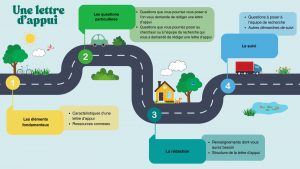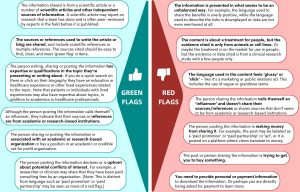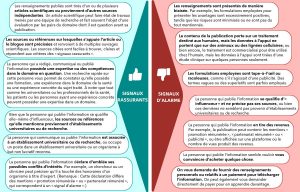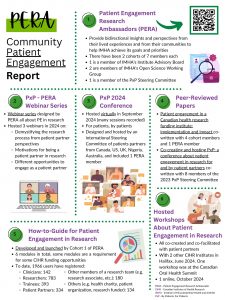Le français suit / French follows
How to Read a Scientific Paper – Introduction
Co-Created by Dawn Richards and Jim Kempster with input from CIHR-IMHA PERA members
Graphics created by Tianna Magel
Scientific papers have a very specific layout. Often each journal that publishes papers provides authors with instructions about what sections should be included in a paper. Each section of a paper has its own purpose and contents.
We know that scientific papers are read by many different people who bring different perspectives to research teams. We heard from patient partners that it would be valuable to understand more about the layout of scientific papers and what they can expect to see in each section.
As a result, we co-created this resource with patient partners. This resource is for anyone who reads or wants to read scientific papers. The resource is laid out in the format of a typical scientific paper. Instead of each section of the resource being filled with information about a specific research project, each section describes what you can expect to be covered in that section. There are also some resources provided that might be helpful to you.
We hope this helps de-mystify scientific papers for you and helps you in your own work in research.
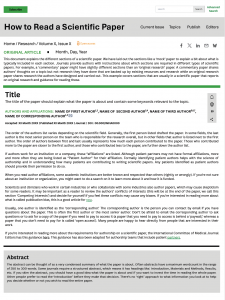
How to Read a Scientific Paper
This document explains the different sections of a scientific paper. We have laid out the sections like a ‘mock’ paper to explain a bit about what is typically included in each section. Journals provide authors with instructions about which sections are required in different types of scientific papers. For example, a ‘commentary’ paper might have slightly different sections than an ‘original research’ paper. A commentary paper shares authors’ thoughts on a topic but not research they have done that are backed up by existing resources and research while an original research paper shares research the authors have designed and carried out. This example covers sections that are usually in a scientific paper that reports on original research and guidance for reading these.
Title
The title of the paper should explain what the paper is about and contain some keywords relevant to the topic.
Authors and Affiliations
The order of the authors list varies depending on the scientific field. Generally, the first person listed drafted the paper. In some fields, the last author is the most senior person on the team who is responsible for the research overall, but in other fields that author is listed next to the first author. The order of authors between first and last usually represents how much each person contributed to the paper. Those who contributed more to the paper are closer to the first author, and those who contributed less to the paper are further down the author list.
If authors work for an institution or a company, these “affiliations” are listed. Although patient partners may not have formal affiliations, more and more often they are being listed as “Patient Author” for their affiliation. Formally identifying patient authors helps with the science of authorship and in understanding how many patients are contributing to writing scientific papers. Any patients identified as patient authors should be asked to provide their permission to do so.
When you read author affiliations, some academic institutions are better known and respected than others (rightly or wrongly). If you’re not sure about an institution or organization, you might want to do a search on it to learn more about it and how it is funded.
Scientists and clinicians who work in certain industries or who collaborate with some industries also author papers, which may cause skepticism for some readers. It may be important as a reader to review the authors’ conflicts of interests (this will be at the end of the paper, we call this section ‘Competing Interests’) and decide for yourself if you feel these conflicts may cause any biases. If you’re interested in reading more about what is called publication bias, this is a good article for you.
Usually, one author is identified as the ‘corresponding author.’ The corresponding author is the person you can contact by email if you have questions about the paper. This is often the first author or the most senior author. Don’t be afraid to email the corresponding author to ask questions or to ask for a copy of the paper if you need to pay to access it (a paper that you need to pay to access is behind a ‘paywall,’ whereas a paper that you don’t need to pay for is called ‘open access’). Many people are happy to hear directly from people that are interested in their work.
If you’re interested in reading more about the requirements for authorship on a scientific paper, the International Committee of Medical Journal Editors has this guidance here. This guidance has also been adapted for authorship teams that include patient partners.
Abstract
The abstract can be thought of as a very condensed summary of what the paper is about. Often abstracts have a maximum word count in the range of 250 to 300 words. Some journals require a structured abstract, which means it has headings like: Introduction, Materials and Methods, Results, etc. If you skim the abstract, you should have a good idea what the paper is about and if you want to invest the time in reading the whole paper. Other people prefer to read the ‘Introduction’ before they make that decision. There’s no ‘right’ approach to what information you look at to help you decide whether or not you wish to read the entire paper.
Plain Language Summary
A plain language summary is not always required by the journal. If there is a plain language summary, it often has a word count maximum of about 250-300 words. It should be written at a language level that the general population can understand. Its contents should not be identical to the Abstract, but it should provide an easy-to-read snapshot of the paper.
Introduction or Background
This section helps set the context for the content of the paper. It covers a bit about the field of research and how the specific project (or group of projects) fits in to that field. For example, it should help the reader understand the field generally, including any gaps or the need for this work. It should also share how the work fills any gaps in the field or the reasons for doing the research. It may also set what readers can expect in the paper.
Materials and Methods
Sometimes this section may just be called Methods, depending on research that’s being reported. This section describes exactly what materials were used and how the research was done and should provide enough information so that another research team could replicate the work.
For experimental research that is done in a lab, this section will describe any chemicals, instruments, readings that were taken, and other experimental details. For other types of work, it may describe, for example, how a survey was developed, launched, and responses collected and analyzed or how focus groups were carried out. It will also describe how the research was designed to minimize bias in the results of the research. If animals were used in the study or if human participants or samples were involved, special approvals may be needed to do the research. Those approvals will be noted in this section.
Results
The Results section describes the findings of the research. It often has text along with charts or graphics (sometimes called figures) and tables that present the data from the research. This section simply presents the results rather than putting them in to context within the field of study which comes in the Discussion section.
The Results section may include information about numbers and statistics. For example, it may include how many people participated in the study or the number of analyzed samples. The number may be important in terms of what the results say. Specific words such as significant or nonsignificant have a statistical definition which is important to keep in mind. This glossary from Statistics Canada might be helpful about statistics terms and this Statistics Cheat Sheet offers some basics about statistics.
This section should include all results – not just the expected or easy to interpret ones. Sometimes researchers find things they didn’t expect, and those should also be reported here.
Sometimes the Results and Discussion sections are combined in a paper, depending what the journal requires.
Discussion
The Discussion section is an opportunity to put the results of the work in to the larger context of other work in the field, and to make interpretations of the results according to what is known in the field already. Here results are generally compared and contrasted to other work that is published on the same topic. Concrete ideas about why results are similar to or different from other results in the field should be presented.
Any unanticipated or hard to explain results should be discussed here. The researchers may explain their thoughts around these results, and may comment that these results offer an opportunity for future research and research directions.
Depending on your relationship to or knowledge about the area of research, you may even interpret the results differently from the authorship team. Sometimes the results of research can be very context or perspective dependent.
This section should also describe any limitations that the authors have identified in the research. This is like describing the boundaries of, or related to, the research. For example, if the people who responded to the survey were from a specific demographic only, results are only relevant to that demographic. For example, if participants were adult, upper middle class women, it would be a stretch to generalize these results to adolescents from a different socioeconomic class. In this case, the authors should note that more research should be done to include other demographics so that the results can be representative of other demographics or more broadly applicable across demographics. Another limitation might be that, due to budget, only 10 people could be included in a focus group. The authors should identify this and include how this might affect the results or the generalizability of the results.
This section might also include the authors’ thoughts on what future work should be done that would further contribute to these findings, broaden them, make them more generalizable, or build on them.
Conclusion
The Conclusion does not need to be a long section. It helps reinforce the main finding(s) of the research, and how the authors filled an identified need or gap that was clearly stated in the Introduction of the paper. In many cases this presents the ‘take home’ message for readers and potential next steps.
After these main sections of a scientific paper, there can be a number of additional sections that tell you more about the research. Depending on the journal, these sections may be a bit different, but here are some of the main ones that are often seen.
Availability of data and materials
This section tells other researchers if they are able to access the data and materials generated by or used by the authors for their own work. Open science is a movement in research to make data and materials more readily available to others in a field. This type of approach is helpful to move research forward by sharing results and materials in a transparent manner that leads to less ‘research waste’ overall. There may be valid reasons that data and materials are not made available for others, and these should be stated if that’s the case.
Abbreviations
Sometimes a list of abbreviations or acronyms used in the paper along with what they stand for is provided at the end of the paper.
References
This is a list of all of the scientific papers and maybe websites or other resources that the authors have referenced in writing the paper. This can be a good place to ‘dig’ if you’re interested in exploring and learning more about topics related to the article.
Some examples of references are listed here:
1. Smith, John et al. Year. Article title. Journal, volume (issue), pages
2. Institute of Musculoskeletal Health and Arthritis. Year. Article title. Journal, volume (issue), pages
Acknowledgements
This is a section that lists individuals who contributed to the research and maybe even the paper, but who did not meet the requirements to be listed as an author.
Funding
This section discloses which organization(s) or funding body(ies) provided funding support for the research. This might include a health funding agency, a health charity or patient organization, a philanthropic organization, industry, or other organizations. The funding source may be important to you in terms of deciding about the objectivity or the motivations behind the research. For example, if research is funded by industry, you may have concerns about potential bias or conflict of interest, or that the results that are shared are ‘positive’ results only.
Author Information
Generally, this section includes author affiliations and explains each author’s contribution to the work (for example, if they designed the research, carried it out, how they contributed to the manuscript, etc.). Sometimes authors are just listed here by their initials.
Ethics declarations
While ethics approval is usually also cited in the main body of the paper, information will also be listed here about whether or not it was required for the work. Generally, research that involves human participants requires research ethics review. If ethics approval was not needed for the work, or if a ‘waiver’ was received from a research ethics board, this is noted in this section. A waiver is a document provided by an ethics board and means the research team was permitted to do the research without receiving informed consent from participants. There may be a few instances where consent is not formally required, for example, if the ethics board deems the research to be of minimal risk to participants, or if obtaining informed consent is not practical for a variety of reasons.
Consent for publication
This goes along with the ethics declaration. Generally, when data from human participants is part of research, those participants are consented for the research results to be used in a research publication. There are some instances where people may not be consented and a waiver from a research ethics board is obtained for ethics. This would be noted here and in the ethics declaration.
Competing interests
Any potential conflicts of interest are listed in this section – these may be perceived or real competing interests, and which have the potential to create bias. For example, if an author has accepted funding from industry for the work presented or for other work they’ve done, this would be declared in this section. All authors, including patient authors, need to declare any competing interests.
Supplementary Information
This section may include files or data that is available for download or on request by readers of the paper. Supplementary Information includes items or documents that might be useful for others to use or help inform them, but that is not included in the main body of the paper. For example, while some of the data from the research may be shared in the main body of the paper as a table, a complete set of data or other tables that were simply too much information for the main body may be included in this section. Another example of a file found here might be the entire wording of a survey whose results are summarized in the paper.
Comment lire un article scientifique – Introduction
Par Dawn Richards et Jim Kempster, avec la contribution d’ambassadeurs de la recherche axée sur le patient de l’IALA des IRSC
Éléments graphiques par Tianna Magel
La structure d’un article scientifique est très spécifique, à tel point que la plupart des revues fournissent des instructions détaillant le contenu et les objectifs que doivent comprendre les sections des articles qui leur sont soumis.
Ces articles étant aujourd’hui lus par des personnes apportant une grande diversité de contributions aux équipes de recherche, des patients partenaires ont mis en lumière l’importance d’expliquer leur structure et ce que les lecteurs peuvent attendre de chaque section.
Avec leur contribution, nous avons entrepris de créer le présent document, qui s’adresse à tous types de lecteurs d’articles scientifiques, en suivant la structure d’un article scientifique conventionnel. Plutôt que d’offrir des renseignements sur un projet de recherche, chaque section décrit le contenu que vous retrouveriez dans la section correspondante d’un véritable article. Des ressources complémentaires sont également fournies.
Nous espérons que les prochains paragraphes vous aideront à déconstruire les mythes qui entourent les articles scientifiques et seront utiles à vos travaux!
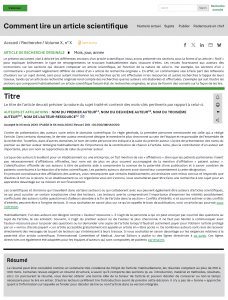
French – How to Read a Scientific Paper
Le présent document vise à décrire les différentes sections d’un article scientifique. Nous avons présenté ces sections sous la forme d’un article « fictif » pour expliquer brièvement le type de renseignements se trouvant habituellement dans chacune d’elles. Les revues fournissent aux auteurs des instructions sur les sections qui doivent composer un article scientifique, en fonction de la nature de celui-ci. Par exemple, les sections d’un « commentaire » pourraient légèrement différer de celles d’un « article de recherche originale ». En effet, un commentaire vise à faire part des réflexions d’auteurs sur un sujet donné, sans pour autant mentionner les recherches qu’ils ont effectuées ni les ressources et autres recherches à l’appui de leurs travaux, tandis qu’un article de recherche originale rend compte des recherches que les auteurs ont élaborées et effectuées. L’exemple qui suit illustre les sections qui composent habituellement un article scientifique faisant état de recherches originales, en plus de fournir des conseils sur la façon de les lire.
Titre
Le titre de l’article devrait préciser la nature du sujet traité et contenir des mots-clés pertinents par rapport à celui-ci.
Auteurs et affiliations
L’ordre de présentation des auteurs varie selon le domaine scientifique. En règle générale, la première personne mentionnée est celle qui a rédigé l’article. Dans certains domaines, le dernier auteur mentionné désigne le membre le plus chevronné au sein de l’équipe et responsable de l’ensemble de la recherche. Toutefois, dans d’autres domaines, le nom de cette personne est indiqué à la suite du premier auteur. L’ordre de présentation des noms du premier au dernier auteur témoigne habituellement de l’importance de la contribution de chacun à l’article. Ainsi, plus la contribution d’un auteur est importante, plus son nom se rapprochera de celui du premier auteur.
Lorsque des auteurs travaillent pour un établissement ou une entreprise, on fait mention de ces « affiliations ». Bien que les patients partenaires n’aient pas nécessairement d’affiliations officielles, leur nom est de plus en plus souvent accompagné de la mention d’affiliation « patient auteur ». L’identification officielle de ces auteurs à titre de patients aide à comprendre la science de la paternité d’une publication et à savoir combien de patients contribuent à la rédaction d’articles scientifiques. Les patients auteurs doivent avoir donné leur consentement à cette désignation.
En prenant connaissance des affiliations des auteurs, vous remarquerez que certains établissements universitaires sont mieux connus et respectés que d’autres (à tort ou à raison). Si un établissement ou un organisme vous est inconnu, vous souhaiterez peut-être faire une recherche à son sujet pour en apprendre davantage sur sa mission et son financement.
Les scientifiques et cliniciens qui travaillent dans certains secteurs ou qui collaborent avec eux peuvent également être auteurs d’articles scientifiques, ce qui peut susciter un certain scepticisme chez des lecteurs. Les lecteurs avertis comprendront l’importance d’examiner les intérêts possiblement conflictuels des auteurs (cette question est d’ailleurs abordée à la fin de l’article dans la section « Conflits d’intérêts ») et sauront estimer si des conflits d’intérêts peuvent être à l’origine de biais. Si vous souhaitez en savoir plus sur ce qu’on appelle le biais de publication, voici un article qui pourrait vous intéresser.
Habituellement, l’un des auteurs est désigné comme « l’auteur-ressource ». Il s’agit de la personne à qui on peut envoyer par courriel des questions au sujet de l’article, le cas échéant. Souvent, il s’agit du premier auteur ou de l’auteur le plus chevronné. Il ne faut pas hésiter à communiquer avec l’auteur-ressource pour lui poser des questions ou lui demander une copie de l’article lorsqu’il faudrait autrement payer pour l’obtenir (article protégé par un « verrou d’accès payant »; un article accessible gratuitement est appelé un article en « libre accès »). De nombreux auteurs sont ravis de recevoir directement des messages de la part de lecteurs qui s’intéressent à leurs travaux. Si vous souhaitez en savoir davantage sur les exigences relatives à la paternité d’un article scientifique, l’International Committee of Medical Journal Editors a publié ici des lignes directrices à ce sujet. Ces lignes directrices ont également été adaptées pour les équipes d’auteurs qui sont composées de patients partenaires.
Résumé
Le résumé peut être considéré comme un sommaire très condensé de l’objet de l’article. Habituellement, les résumés comptent au plus de 250 à 300 mots. Certaines revues exigent un résumé structuré, à savoir qu’il comporte des sections (p. ex. introduction, matériel et méthodes, résultats, etc.). En parcourant le résumé, vous devriez obtenir une bonne idée de la teneur de l’article et pouvoir décider de consacrer ou non le temps nécessaire pour le lire en entier. D’autres lecteurs préfèrent lire l’introduction avant de prendre cette décision. Il n’y a pas de « bonne » approche quant à l’information sur laquelle se fonder pour décider de lire ou non l’article dans sa version intégrale.
Résumé en langage simple
Un résumé en langage simple n’est pas toujours exigé par la revue qui publie l’article, mais s’il l’est, il ne compte habituellement pas plus de 250 à 300 mots. Il doit être rédigé dans un langage accessible au grand public. Son contenu ne doit pas être identique à celui du résumé, mais doit donner un aperçu de l’article facile à lire.
Introduction ou contexte
Cette section aide à établir le contexte du contenu de l’article. On y traite brièvement du domaine de recherche et de la façon dont le projet (ou le groupe de projets) en particulier s’inscrit dans ce domaine. Par exemple, elle devrait aider le lecteur à comprendre le domaine de façon générale, y compris les limites ou le bien-fondé des travaux de recherche effectués. Elle devrait également expliquer en quoi ces travaux permettent de combler des lacunes dans le domaine ou les raisons pour lesquelles la recherche a été effectuée. Cette section peut aussi indiquer ce à quoi le lecteur peut s’attendre dans l’article.
Matériel et méthodes
Cette section est parfois simplement appelée « Méthodes », selon la nature de la recherche dont il est question. Elle décrit avec précision le matériel utilisé et la façon dont la recherche s’est déroulée. On devrait y trouver suffisamment de détails pour qu’une autre équipe de recherche puisse reproduire les travaux. Dans le cas d’une recherche expérimentale réalisée en laboratoire, cette section décrira par exemple les produits chimiques et les instruments utilisés, ainsi que les mesures obtenues, en plus de fournir d’autres précisions à propos de l’expérience. Dans le cas d’autres types de travaux, elle peut notamment préciser la façon dont une enquête a été élaborée et mise en œuvre, et la façon dont les réponses ont été recueillies et analysées, ou encore dont le travail en groupes de discussion a été réalisé. On pourra également y apprendre comment la recherche a été conçue pour réduire au minimum les risques de biais dans les résultats de la recherche. Si des animaux ont été utilisés dans le cadre de l’étude, si des participants humains ont été mis à contribution ou encore si des échantillons ont été utilisés, des approbations spéciales pourraient devoir être obtenues pour mener à bien la recherche. Ces approbations seraient alors indiquées dans cette section.
Résultats
La section « Résultats » décrit les conclusions de la recherche. Elle se compose souvent de textes, de diagrammes ou de graphiques (parfois appelés figures) et de tableaux qui présentent les données de la recherche. Cette section présente simplement les résultats plutôt que leur mise en contexte dans le domaine de l’étude (une information qui se trouve plutôt dans la section « Discussion »).
La section « Résultats » peut comprendre de l’information sur les chiffres et les statistiques. Par exemple, on peut y indiquer le nombre de personnes qui ont participé à l’étude ou le nombre d’échantillons analysés. Ces chiffres peuvent être importants pour comprendre la signification de ces résultats. Des termes comme « significatif » ou « non significatif » correspondent, en statistique, à une définition précise qu’il importe de garder à l’esprit. Statistique Canada a publié un glossaire qui pourrait être utile pour comprendre les termes utilisés dans le domaine de la statistique. Cet aide-mémoire présente quelques notions de base dans ce domaine. Cette section doit comprendre tous les résultats, et non pas seulement les résultats attendus ou faciles à interpréter.
Parfois, les chercheurs constatent des résultats auxquels ils ne s’attendaient pas, et ceux-ci devraient aussi être rapportés dans cette section.
Dans certains cas, lorsque la revue l’exige, les sections « Résultats » et « Discussion » sont combinées.
Discussion
La section « Discussion » permet de mettre en perspective les résultats de la recherche dans le contexte plus large d’autres travaux effectués dans le domaine. On peut aussi y proposer des interprétations des résultats à la lumière des connaissances déjà acquises dans le domaine en question. Les résultats sont généralement comparés à ceux d’autres travaux publiés sur le même sujet. Cette section devrait donner des pistes concrètes pour expliquer pourquoi les résultats sont semblables à d’autres résultats constatés dans le domaine en cause ou différents de ceux-ci.
On devrait discuter dans cette section de tout résultat imprévu ou difficile à expliquer. Les chercheurs peuvent expliquer ce qu’ils pensent de ces résultats et indiquer que ceux-ci présentent une piste d’enquête pour des recherches futures.
Selon votre relation avec le domaine de recherche ou vos connaissances en la matière, votre interprétation des résultats pourrait même différer de celle des auteurs, car les résultats de la recherche sont parfois fortement tributaires du contexte ou des perspectives. Cette section devrait également décrire les limites de la recherche que les auteurs ont cernées. Il s’agit en quelque sorte de décrire ce qui circonscrit la portée de la recherche ou les éléments limitatifs connexes. Par exemple, dans le cas de répondants à une enquête issus seulement d’un groupe démographique particulier, on y indiquerait que les résultats ne sont pertinents que pour ce groupe. Autre exemple, si les participantes étaient des femmes adultes de la classe moyenne supérieure, on y indiquerait qu’il est exagéré d’extrapoler ces résultats aux adolescents d’une classe socioéconomique différente. Dans ces cas, les auteurs devraient indiquer qu’il faut approfondir les recherches afin d’inclure d’autres données pour que les résultats puissent être représentatifs d’autres groupes démographiques ou plus largement applicables à l’ensemble des groupes démographiques. Une autre limite pourrait résider dans le fait que seulement 10 personnes ont pu participer à un groupe de discussion en raison du budget. Les auteurs devraient alors le préciser et indiquer en quoi cette limite pourrait avoir une incidence sur les résultats ou sur leur généralisabilité.
Les auteurs pourraient également utiliser cette section pour faire état de leurs réflexions sur les travaux futurs qui devraient être effectués et qui appuieraient davantage ces constatations, les élargiraient, les rendraient plus généralisables ou s’en inspireraient.
Conclusion
La section « Conclusion » ne doit pas nécessairement être longue. Elle sert à renforcer les principales constatations de la recherche et à réitérer la façon dont les auteurs ont comblé un besoin ou une lacune clairement énoncés dans la section « Introduction » de l’article. Dans bien des cas, cette section circonscrit pour le lecteur le message à retenir et souligne les prochaines étapes possibles.
Plusieurs autres sections peuvent s’ajouter à la suite de ces grandes parties pour donner de l’information supplémentaire au sujet de la recherche. Ces sections peuvent varier quelque peu selon la revue, mais en voici quelques-unes qu’on observe souvent.
Accessibilité des données et du matériel
Cette section indique aux autres chercheurs s’ils sont en mesure d’accéder aux données et au matériel produits ou utilisés par les auteurs pour leurs propres travaux. En recherche, la science ouverte est un mouvement qui vise à rendre les données et le matériel plus facilement accessibles aux autres chercheurs du domaine. Cette approche est utile pour faire avancer la recherche en diffusant les résultats et le matériel de façon transparente, de manière à réduire globalement le « gaspillage d’efforts de recherche ». Il peut exister des raisons valables pour lesquelles les données et le matériel ne sont pas mis à la disposition d’autres chercheurs. En pareil cas, ces raisons devraient être énoncées.
Abréviations
On présente parfois à la fin de l’article une liste des abréviations ou acronymes qui y sont utilisés, ainsi que leur signification.
Références
Il s’agit d’une liste de tous les articles scientifiques et des sites Web ou autres ressources auxquels les auteurs se sont reportés pour rédiger leur article. Les intéressés y trouveront un bon point de départ pour explorer à fond des sujets en lien avec l’article.
Voici quelques exemples de la façon dont les références sont présentées :
- SMITH, John, et coll. «Titre de l’article », Revue, vol., no, mois et année, pages.
- INSTITUT DE L’APPAREIL LOCOMOTEUR ET DE L’ARTHRITE. «Titre de l’article », Revue, vol., no, mois et année, pages.
Remerciements
Il s’agit de la section où l’on énumère les personnes qui ont contribué à la recherche et peut-être même à l’article, mais qui ne répondaient pas aux critères pour figurer à titre d’auteurs.
Financement
C’est dans cette section que l’on mentionne les bailleurs de fonds, c’est-à-dire les organismes qui ont fourni un soutien financier pour réaliser la recherche. Il peut s’agir d’un organisme de financement ou de charité dans le domaine de la santé, d’une association de patients, d’une organisation philanthropique, d’un établissement du secteur privé ou d’un autre type d’organisation. La source du financement peut être une information importante pour mesurer l’objectivité de la recherche ou cerner les motivations qui la sous-tendent. Par exemple, si la recherche est financée par le secteur privé, vous pourriez avoir des préoccupations au sujet d’un éventuel parti pris ou conflit d’intérêts, ou de la possibilité que les résultats communiqués soient uniquement les résultats « positifs ».
Renseignements sur les auteurs
En règle générale, cette section permet d’indiquer les affiliations des auteurs et de décrire la contribution de chacun d’eux aux travaux (p. ex. s’ils ont conçu la recherche, l’ont réalisée, s’ils ont contribué à l’article, etc.). Parfois, on inscrit simplement les initiales des auteurs dans cette section.
Déclaration relative à l’éthique
Bien que l’approbation en matière d’éthique soit habituellement indiquée dans le corps de l’article, cette section permet de préciser si elle était requise ou non pour réaliser les travaux de recherche. En règle générale, une recherche qui mobilise des participants humains nécessite un examen éthique de la recherche. Si aucune approbation à cet égard n’était exigée pour réaliser les travaux, ou si une « exemption » a été reçue d’un comité d’éthique de la recherche, ces précisions sont indiquées dans cette section. Un document d’exemption fourni par un comité d’éthique signifie que l’équipe de recherche a été autorisée à mener les travaux sans avoir obtenu le consentement éclairé des participants. Il existe des situations où le consentement n’est pas exigé formellement; par exemple, si le comité d’éthique estime que la recherche présente un risque minimal pour les participants ou si l’obtention du consentement éclairé n’est pas réalisable pour diverses raisons.
Consentement à la publication
Cette section va de pair avec la déclaration relative à l’éthique. En règle générale, lorsque les données des participants humains font partie de la recherche, ceux-ci consentent à ce que les résultats soient utilisés dans une publication. Dans certains cas, le consentement des participants n’est pas obtenu, et une exemption est accordée par un comité d’éthique de la recherche. La situation serait expliquée dans cette section et dans celle sur la déclaration relative à l’éthique.
Conflits d’intérêts
Tous les conflits d’intérêts potentiels sont décrits dans cette section. Il peut s’agir de conflits d’intérêts réels ou perçus qui pourraient créer un biais. Par exemple, si un auteur a accepté du financement du secteur privé pour le travail présenté ou pour d’autres travaux qu’il a réalisés, il le déclarerait dans cette section. Tous les auteurs, y compris les patients auteurs, doivent déclarer tout conflit d’intérêts.
Documents supplémentaires
C’est dans cette section que l’on mentionne les fichiers ou les données qui peuvent être téléchargés ou demandés par le lecteur. Il peut s’agir d’articles ou de documents utiles, mais qui ne se trouvent pas dans le corps de l’article de recherche. Par exemple, ce dernier peut inclure une partie des données de la recherche sous forme de tableau, sans toutefois comprendre l’ensemble des données ou des tableaux pour ne pas trop alourdir le texte; cette information pourrait alors être présentée dans cette section. On pourrait également trouver dans cette section le texte complet d’une enquête dont les résultats sont résumés dans l’article, par exemple.

